
Halton Christian "Chip" Arp was an American astronomer. He is remembered for his 1966 book Atlas of Peculiar Galaxies, which catalogued unusual looking galaxies and presented their images.

The Atlas of Peculiar Galaxies is a catalog of peculiar galaxies produced by Halton Arp in 1966. A total of 338 galaxies are presented in the atlas, which was originally published in 1966 by the California Institute of Technology. The primary goal of the catalog was to present photographs of examples of the different kinds of peculiar structures found among galaxies.

Arp 220 is the result of a collision between two galaxies which are now in the process of merging. It is the 220th object in Halton Arp's Atlas of Peculiar Galaxies.

NGC 3432 is an edge-on spiral galaxy that can be found in the northern constellation of Leo Minor. It was discovered by German-British astronomer William Herschel on March 19, 1787. This galaxy is located at a distance of 40 million light-years (12.3 Mpc) from the Milky Way. It is interacting with UGC 5983, a nearby dwarf galaxy, and features tidal filaments and intense star formation. Because of these features, it was listed in Halton Arp's Atlas of Peculiar Galaxies.

Arp 273 is a pair of interacting galaxies, 300 million light years away in the constellation Andromeda. It was first described in the Atlas of Peculiar Galaxies, compiled by Halton Arp in 1966. The larger of the spiral galaxies, known as UGC 1810, is about five times more massive than the smaller galaxy. It has a disc that is tidally distorted into a rose-like shape by the gravitational pull of the companion galaxy below it, known as UGC 1813. The smaller galaxy shows distinct signs of active star formation at its nucleus, and "it is thought that the smaller galaxy has actually passed through the larger one."
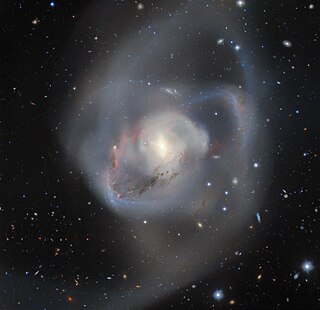
NGC 7727 is a peculiar galaxy in the constellation Aquarius. It harbors two galactic nuclei, each containing a supermassive black hole, separated 1,600 light years apart.

NGC 507, also known as Arp 229, CGCG 502-67, MCG 5-4-44, PGC 5098, UGC 938, and V V 207, is a lenticular galaxy in the constellation Pisces. It was described as being "very faint", "pretty large", "round", "brighter in the middle", and "south of NGC 508" by John Dreyer in the New General Catalogue. The two galaxies are a part of the Atlas of Peculiar Galaxies, where NGC 507 is described as "Circular or near circular rings of small density difference."

NGC 7625, or Arp 212, is a peculiar galaxy in the constellation of Pegasus. It was discovered on October 15, 1784, by William Herschel. In his New General Catalogue (1888), J. L. E. Dreyer described it as pretty bright, considerably small, round, with a suddenly much brighter middle. It is located at an estimated distance of 78 million light-years from the Milky Way galaxy.

IC 4271 is a spiral galaxy located some 800 million light-years away in the Canes Venatici constellation. It is 130,000 light-years in diameter. IC 4271 was first located on July 10, 1896, by Stephane Javelle, a French astronomer. It hosts a Seyfert type 2 nucleus, containing an acceleration disc around its supermassive black hole which releases large amounts of radiation, hence its bright appearance. IC 4271 appears to be interacting with its smaller neighboring galaxy, PGC 3096774.
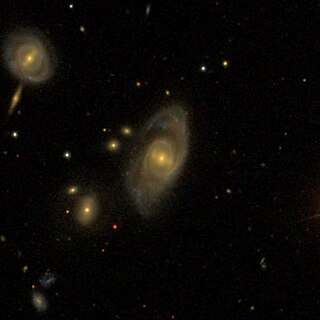
UGC 717 is a barred spiral galaxy located in Pisces. The galaxy is located 520 million light-years away from the solar system. It is designated as Arp 11 in the Atlas of Peculiar Galaxies which was produced by Halton Arp. UGC 717 falls under the category of spirals that have split-arms. It is known to have a LINER active galactic nucleus according to SIMBAD.

PGC 4789 is a distant barred spiral galaxy in the Pisces constellation. It is located 675 million light-years from the Milky Way and seems to be interacting with its neighboring galaxies. it is known as Arp 48 in the Atlas of Peculiar Galaxies catalogue. In this class, PGC 4789 falls into galaxies that have at least one low surface brightness companion.

UGC 934, known as PGC 5085, is a large spiral galaxy about 470 million light-years away from the solar system. It is located in the constellation of Pisces and about 285,000 thousand light-years in diameter. With its neighboring galaxy PGC 212740, they together form Arp 70, the 70th number in the Atlas of Peculiar Galaxies which was created by Halton Arp. In this class, they fall under spiral galaxies that have a small high-surface brightness companions.
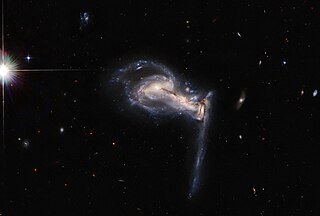
UGC 4653 known as Arp 195, is a trio of interacting galaxies located 763 million light-years away from the solar system in the Lynx constellation. The galaxies are being distorted through gravitational interactions with each other.

UGC 1775 or Arp 10 is a ring galaxy in the constellation Cetus. The galaxy lies about 400 million light years away from Earth, which means, given its apparent dimensions, that UGC 1775 is approximately 220,000 light years across. The galaxy is included in Halton Arp's Atlas of Peculiar Galaxies in the galaxies with split arms category.

UGC 1840 known as Arp 145, are a pair of interacting galaxies located 250 million light-years away from the solar system in the Andromeda constellation. Made up of two galaxies, UGC 1840 NED01 and UGC 1840 NED02, the two galaxies had recently collided with each other in which the elliptical galaxy has penetrated through the spiral galaxy's nucleus leaving a hole in its middle, thus forming a ring galaxy. With a diameter of 1.3 arc minutes, close to 100,000 thousand light-years, they are roughly the same size as the Milky Way.
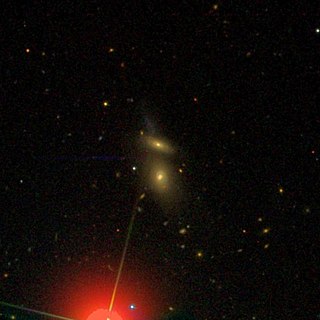
UGC 224 known as Arp 201, are pair of interacting galaxies located 860 million light-years in the constellation of Pisces.
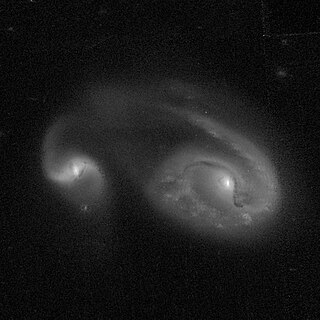
NGC 5279 is a spiral galaxy in the constellation Ursa Major. It was discovered by German-British astronomer William Herschel in 1789. NGC 5279 is in gravitational interaction with the galaxy NGC 5278. This pair of galaxies appears in Halton Arp's Atlas of Peculiar Galaxies under the designation Arp 239. The luminosity class of NGC 5279 is I1. NGC 5279 is a galaxy whose core shines in the ultraviolet region. It is listed in the Markarian catalog under the designation Mrk 271.
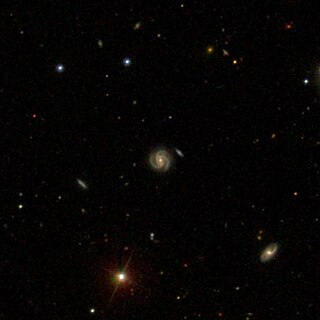
Arp 60 also known as PGC 1762846, is a barred spiral galaxy located in Coma Berenices. It is located 958 million light-years from the Solar System and has an approximate diameter of 95,000 light-years.
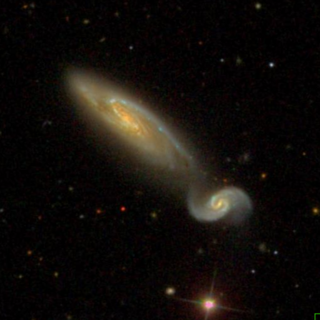
NGC 3800 is an intermediate spiral galaxy located in the constellation Leo. Its speed relative to the cosmic microwave background is 3,653 ± 24 km/s, which corresponds to a Hubble distance of 53.9 ± 3.8 Mpc. NGC 3800 was discovered by German-British astronomer William Herschel in 1784.

NGC 3799 is a barred spiral galaxy located in the constellation Leo. Its speed relative to the cosmic microwave background is 3,659 ± 24 km/s, which corresponds to a Hubble distance of 54.0 ± 3.8 Mpc. NGC 3799 was discovered by British astronomer John Herschel in 1832.




















